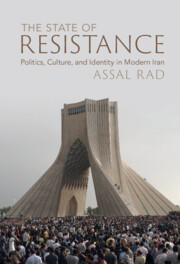Book contents
- The State of Resistance
- The State of Resistance
- Copyright page
- Dedication
- Contents
- Figures
- Acknowledgments
- Note on Transliteration
- 1 Introduction
- 2 The Foreign Shah and the Failure of Pahlavi Nationalism
- 3 The Islamic Republic and Its Culture of Resistance
- 4 Iranian Identity and Popular Music
- 5 Media and the Struggle over Representation
- 6 Conclusion
- 7 Epilogue
- Select Bibliography
- Index
2 - The Foreign Shah and the Failure of Pahlavi Nationalism
Published online by Cambridge University Press: 18 August 2022
- The State of Resistance
- The State of Resistance
- Copyright page
- Dedication
- Contents
- Figures
- Acknowledgments
- Note on Transliteration
- 1 Introduction
- 2 The Foreign Shah and the Failure of Pahlavi Nationalism
- 3 The Islamic Republic and Its Culture of Resistance
- 4 Iranian Identity and Popular Music
- 5 Media and the Struggle over Representation
- 6 Conclusion
- 7 Epilogue
- Select Bibliography
- Index
Summary
Chapter 2 provides historical background of Pahlavi monarchy and its nation-state project. To be a modern nation-state required a cohesive national identity and complimenting narrative. The significance of that account was not lost on the shah, who tried to formulate an uninterrupted history of Iranian dominion. Chapter 2 relies heavily on a close reading of the words of Mohammad Reza Pahlavi, to shed light on the shah’s rationale for upholding this narrative. The shah understood that Iran could not forge its independence and image as a modern nation-state without freedom from foreign control. According to the shah, it was his father who "created" the modern Iranian state and saved Iran from the ineptness of its previous dynasty. This chapter also challenges the shah’s account and explores how his subjects saw him as foreign and as a symbol of Iran’s capitulation to external powers. The shah’s failed nationalism left space for his opposition to produce an alternative narrative that captured the imagination of the masses of Iranian people. Chapter 2 lays the foundation for the sections that follow by presenting not only the newly constructed image of Iranian nationalism, but also why it was needed in order to advance the cause of independence.
Keywords
- Type
- Chapter
- Information
- The State of ResistancePolitics, Culture, and Identity in Modern Iran, pp. 18 - 52Publisher: Cambridge University PressPrint publication year: 2022



